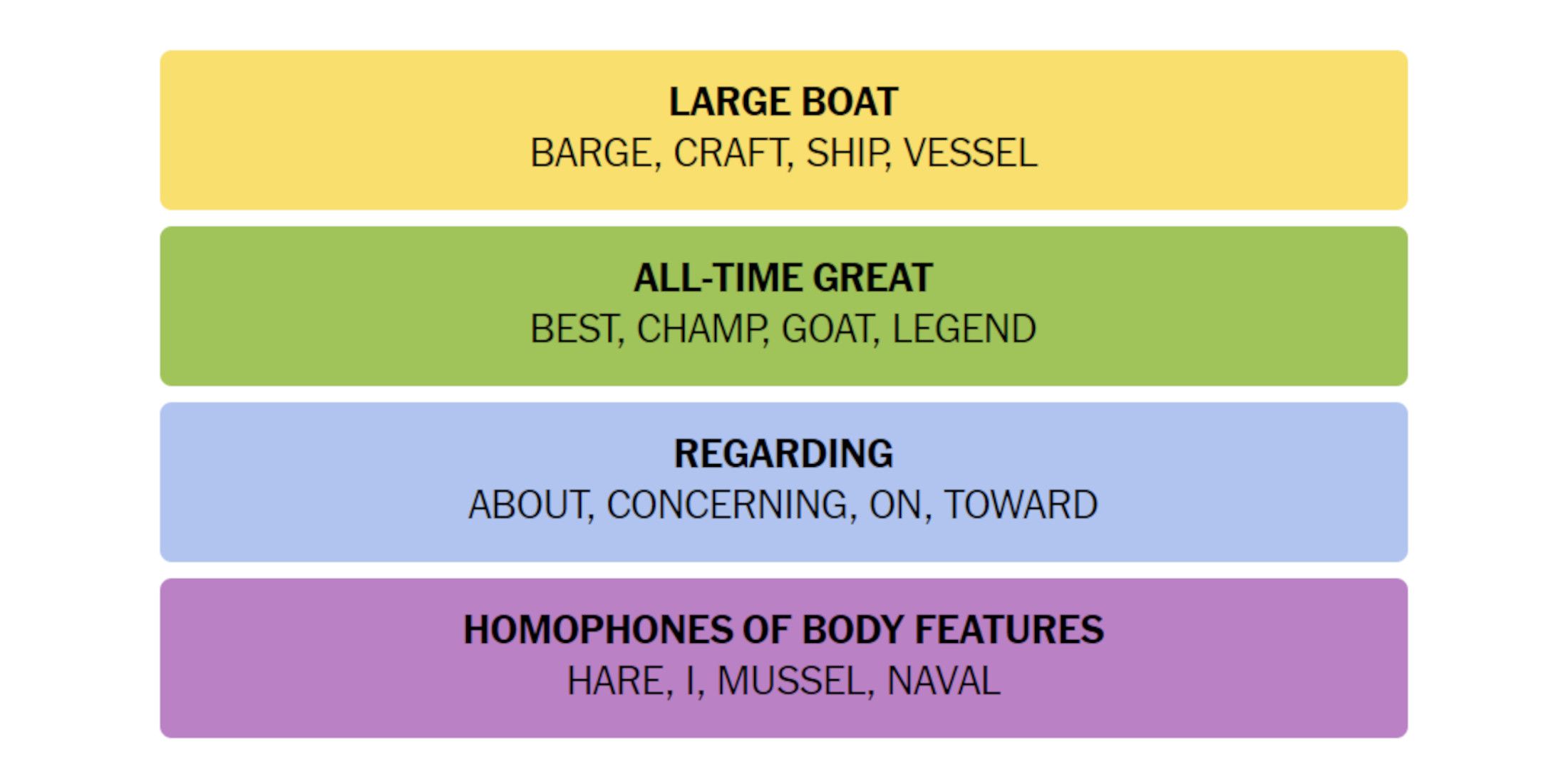The New York Times’ Influence and Reach: Nyt Connections

The New York Times, often referred to as “The Gray Lady,” has been a dominant force in American journalism for over 170 years. Its influence extends far beyond its readership, shaping public opinion, influencing policy decisions, and even impacting global events.
Historical Significance of the New York Times
The New York Times was founded in 1851 by Henry Jarvis Raymond and George Jones. It quickly established itself as a reliable source of news, earning a reputation for its accuracy and objectivity. Its commitment to investigative journalism, exemplified by its coverage of the Civil War and the Watergate scandal, cemented its status as a leading newspaper.
Impact on Public Opinion and Discourse
The New York Times’s editorial content has a significant impact on public opinion and discourse. Its articles, editorials, and op-eds often set the agenda for national conversations, influencing how people think about important issues. For instance, the newspaper’s coverage of the Vietnam War played a crucial role in shaping public perception of the conflict, leading to widespread anti-war sentiment.
Key Events Where the New York Times Played a Pivotal Role
The New York Times has been a key player in shaping global events throughout its history. Here are a few examples:
- The Pentagon Papers: In 1971, the New York Times published the Pentagon Papers, a classified study that revealed the US government’s secret history of the Vietnam War. This publication sparked a major controversy, leading to a landmark Supreme Court case that upheld the freedom of the press.
- The Watergate Scandal: The New York Times’s relentless reporting on the Watergate scandal, which began with a seemingly insignificant break-in at the Democratic National Committee headquarters, eventually led to the resignation of President Richard Nixon. The newspaper’s investigative journalism exposed corruption and abuse of power, setting a precedent for holding government officials accountable.
- The Arab Spring: In 2011, the New York Times played a crucial role in documenting and amplifying the voices of the Arab Spring protests. Its coverage helped to raise awareness of the uprisings across the Middle East and North Africa, inspiring solidarity and galvanizing international support for democratic reform.
Exploring the New York Times’ Network

The New York Times, a prominent media organization, has a vast network of connections that extends beyond its editorial staff. This network encompasses various institutions, individuals, and organizations, influencing the newspaper’s reporting and shaping its overall narrative. Examining these relationships can shed light on potential conflicts of interest and the intricate dynamics within the media landscape.
The New York Times’ Network of Connections, Nyt connections
The New York Times has established relationships with numerous prominent institutions, individuals, and organizations, contributing to its influence and reach. These connections can be categorized as follows:
- Government Agencies: The New York Times maintains relationships with various government agencies, including the White House, the State Department, and the Pentagon. These connections allow the newspaper access to official information and sources, shaping its reporting on government policies and events.
- Corporate Entities: The New York Times has ties to corporations through advertising contracts, sponsorships, and partnerships. These connections can potentially influence the newspaper’s coverage of corporate issues and practices.
- Non-Profit Organizations: The New York Times collaborates with non-profit organizations on various projects, including investigative journalism, public service campaigns, and educational initiatives. These connections can provide the newspaper with access to expertise and resources while influencing its coverage of social issues.
- Academic Institutions: The New York Times has connections with universities and research institutions, providing opportunities for collaboration on research projects, data analysis, and expert opinions. These connections can enrich the newspaper’s reporting and contribute to its credibility.
- Individuals: The New York Times maintains relationships with prominent individuals, including politicians, business leaders, and celebrities. These connections can provide the newspaper with exclusive insights and perspectives, shaping its coverage of specific events or topics.
Potential Conflicts of Interest
The New York Times’ network of connections raises concerns about potential conflicts of interest. The newspaper’s reporting may be influenced by its relationships with various institutions, individuals, and organizations. This influence can manifest in various ways, including:
- Favorable Coverage: The New York Times may provide favorable coverage to entities with whom it has close relationships, potentially neglecting critical scrutiny or negative reporting.
- Suppression of Information: The newspaper may suppress information that could be detrimental to its partners or sources, potentially compromising its journalistic integrity.
- Bias in Reporting: The New York Times’ reporting may reflect the perspectives and agendas of its connected entities, leading to biased or slanted coverage.
- Compromised Independence: The newspaper’s independence may be compromised by its reliance on information and resources from connected entities, potentially affecting its ability to objectively report on sensitive issues.
Analyzing the Network
To better understand the potential impact of the New York Times’ network, it’s crucial to analyze its relationships with various entities. The following table provides a framework for examining these connections:
| Institution/Individual | Connection Type | Nature of Connection | Potential Impact |
|---|---|---|---|
| White House | Government Agency | Access to official information and sources | Potential bias in reporting on government policies and events |
| Corporate Entity | Advertising contract, partnership | Potential influence on coverage of technology and digital media | |
| Human Rights Watch | Non-Profit Organization | Collaboration on investigative journalism projects | Potential influence on coverage of human rights issues |
| Columbia University | Academic Institution | Research collaboration, expert opinions | Potential influence on coverage of academic research and findings |
| Barack Obama | Individual | Interviews, opinion pieces | Potential influence on coverage of political events and policies |
The New York Times’ Editorial Practices

The New York Times, with its long history and vast reach, has established itself as a leading voice in journalism. Its editorial practices, shaped by its connections and influences, play a crucial role in shaping public perception of news events. This section delves into the nuances of the New York Times’ editorial practices, exploring how they have evolved and their impact on the news landscape.
The Influence of Connections on Reporting
The New York Times, like any major news organization, operates within a complex network of relationships. These connections can influence editorial decisions, both consciously and unconsciously. For example, the paper’s close ties to the political and business elite can sometimes lead to a more favorable portrayal of these groups. The paper’s extensive reporting on the 2008 financial crisis, while thorough, was criticized by some for not adequately scrutinizing the role of certain financial institutions that were close to the paper’s leadership. Similarly, the paper’s coverage of the 2016 presidential election was criticized by some for its perceived bias towards Hillary Clinton.
Comparison of Editorial Policies
The New York Times’ editorial policies are generally considered to be more conservative than those of other major news outlets, such as the Washington Post and the Los Angeles Times. This is reflected in the paper’s coverage of social issues, where it has been criticized for its perceived lack of diversity and its focus on elite perspectives. For example, the paper’s coverage of the Black Lives Matter movement has been criticized by some for its lack of nuance and its focus on the negative aspects of the movement.
Impact of Editorial Decisions on Perception
The New York Times’ editorial decisions have a significant impact on the perception of news events. The paper’s reputation for accuracy and objectivity means that its coverage is often seen as authoritative and trustworthy. This can have a powerful influence on public opinion, particularly in the case of complex or controversial issues. For example, the paper’s coverage of the Iraq War was widely seen as influential in shaping public opinion, both in the United States and internationally.
Nyt connections – The New York Times, often referred to as the “Gray Lady,” has a long and storied history, earning it a unique place in the American media landscape. This “sobriquet,” as it’s formally known, sobriquet definition , reflects the newspaper’s long-standing reputation for journalistic integrity and its often-serious tone.
While the Times has evolved to embrace digital platforms, its moniker remains a testament to its enduring legacy.
The New York Times, a publication often lauded for its in-depth reporting and investigative journalism, has also become known for its sometimes-unorthodox use of language. This can be seen in their occasional deployment of “sobriquets,” a term encompassing nicknames, epithets, and other descriptive names , to label individuals or events.
While this approach can add a layer of nuance and intrigue, it can also be criticized for being overly familiar or even condescending, raising questions about the paper’s tone and target audience.
